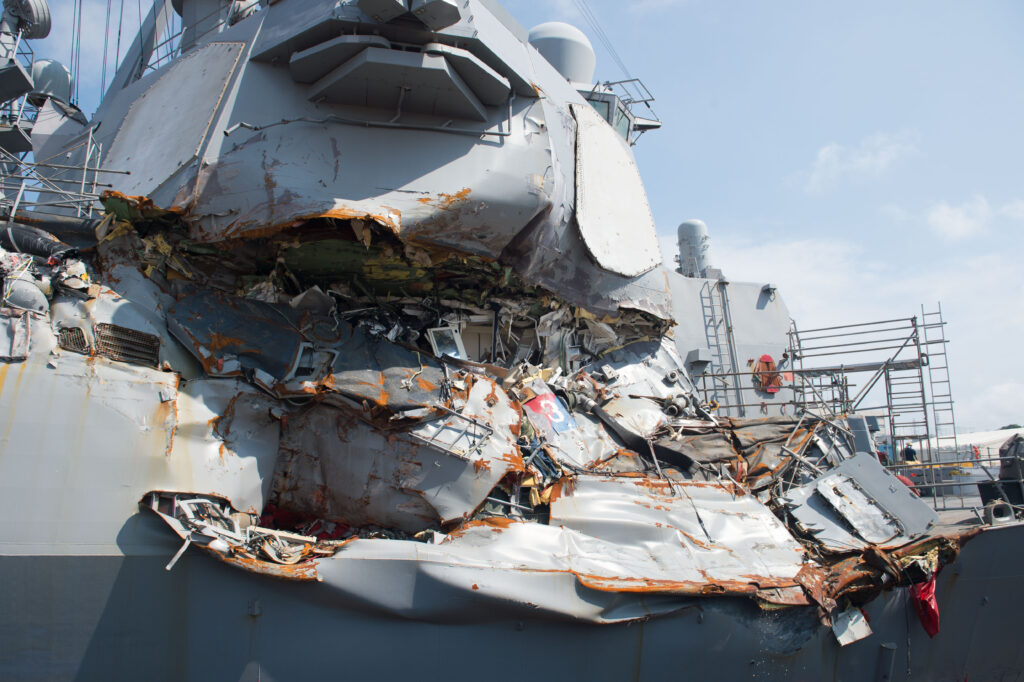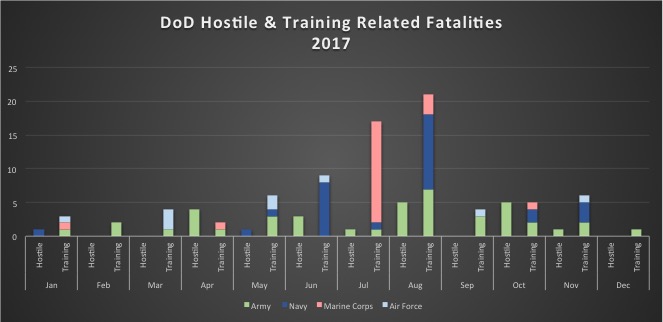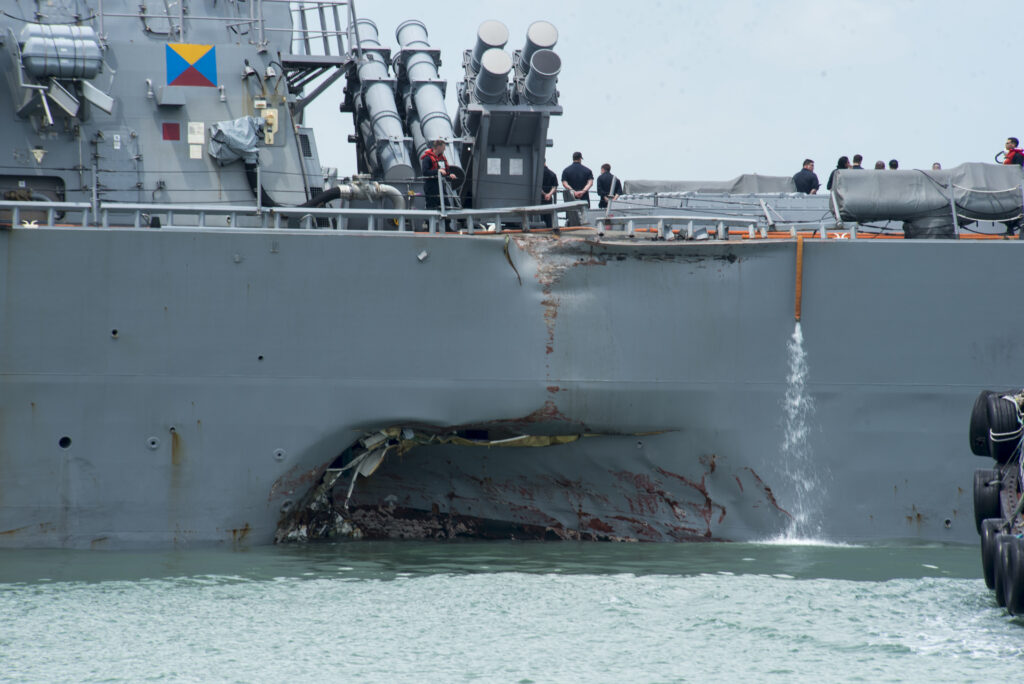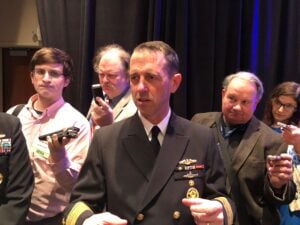Navy’s Fixing Itself, Congress Must Fix Budget: Wittman, Courtney
Posted on

Damage to the destroyer USS Fitzgerald after its collision with a merchant ship.
UPDATED from hearing and House vote WASHINGTON: The Navy is doing a good job addressing the problems revealed by last summer’s fatal collisions at sea, for example by filing criminal charges this week against officers involved, the Republican chairman and ranking Democrat of the House seapower subcommittee say. Now Congress needs to do its part and pass a proper budget, Rep. Rob Wittman and Rep. Joe Courtney both said in separate interviews with Breaking Defense ahead of today’s seapower and readiness hearing.

Rep. Rob Wittman
The Navy Secretary and the Chief of Naval Operations can correct most of the problems on their own authority, both congressmen said, dismissing calls for CNO John Richardson to resign. That said, Wittman and Courtney will gladly make another attempt to repeal the Inouye Amendment restricting naval reorganization in the Pacific, as Secretary Richard Spencer has requested. They will even consider “fine-tuning” (Wittman) or “tweaking” (Courtney) the landmark Goldwater-Nichols Act to make it easier for naval officers to specialize and gain hands-on expertise at sea. But the Navy also needs adequate, stable funding for training, maintenance, and other safety essentials, and that is out of the committee’s hands.
“This is literally costing us lives,” said the man who must make a deal, House Speaker Paul Ryan. It’s rare enough for the Speaker to discuss defense in any depth, yet Ryan appeared at the Center for Strategic & International Studies this morning to discuss defense funding shortfalls for almost half an hour. One of Ryan’s repeated themes was how inadequate budgets led to fatal accidents.
“In total, we lost 80 lives due to training accidents in 2017 alone. That is four times as many as were killed in combat.” (The Speaker seems to be counting all non-combat deaths, including the 17 from the McCain and Fitzgerald collisions, as “training”). “The training accidents alone should be screaming ‘fix this.’”
So can we fix it?

SOURCE: Department of Defense statistics
Budget Brinkmanship
“Right now, we are actually engaged in good faith negotiations” about the budget,” Speaker Ryan said this morning. “I’m optimistic we’re going to get there.” That said, Ryan spent far less time proclaiming optimism than slamming Senate Democrats for holding defense spending “hostage” in order to get concessions on domestic programs and immigration.

Rep. Joe Courtney aboard the aircraft carrier USS TRUMAN.
Seapower chairman Wittman sounded less partisan and more hopeful. Both Democrats and Republican budget hawks like the Freedom Caucus are coming round to support increased defense spending, he told me.
“There’s lot of machinations,…but I think ultimately it gets done. It should have been done sooner,” Wittman said. “We’ll get to the point where we have the necessary dollars for this nation’s defense, and we’ve all been adamant that $634B in base dollars is the floor… I think the Speaker believes that.”
Courtney, the Democrat, was skeptical. “We had a very intense caucus this morning,” he told me. “The first test is going to be tonight… whether or not Ryan can really deliver the votes for his version of a CR (Continuing Resolution).It could be that Ryan can pull a rabbit out of a hat and find 218 votes tonight (in the House) and get 60 votes in the Senate, but I’ll tell you, particularly in the Senate, it’s looking pretty grim.”
UPDATE The CR passed the House by an unexpectedly strong 230-197 vote, but opposition in the Senate seems to be solidifying.
Continuing Resolution (CR) is the term of art for the short-term, stopgap spending bills that essentially put government spending on autopilot at last year’s levels. The upcoming vote is on a new CR to avoid a government shutdown, not a long-term appropriations bill for the entire fiscal year.
“To try and wrap this CR with the flag of the military defies everything that military leadership has been telling us again over the last four, five years: We need a budget, not a CR,” Courtney said. “Out of the 12 months since the president took his oath, we’ve had eight months of CR….It looks like we’re going to get another chunk of CR by hook or by crook in the next 48 hours or so….We’ve got to get an agreement on the budget caps, and in my opinion that’s on the Speaker.”

Rep. Paul Ryan
Wittman agreed that Continuing Resolutions are problematic stopgaps. “We need to get a long-term appropriation for our nation’s defense. We understand how problematic and wasteful CRs are,” he told me.
How much responsibility for the problems lies with Congress and its failure to pass adequate, predictable funding? “Certainly, some rests with Congress, going through these cycles of Continuing Resolutions, where there’s not continuity and certainty in funding creates challenges for (e.g.) maintenance,” Wittman said. “Certainly that’s contributory factor. But. I would still say the preponderance of issues involved in these collisions… is with the Navy.”
Rep. Courtney agreed. There are 58 fixes identified n the CNO’s Comprehensive Review (distinct from the Secretary’s Strategic Readiness Review, with its 23 recommendations). “If you look at the 58 recommendations, an awful lot of them can be implemented internally, and I think the CNO is already implementing…. things like the standard for circadian sleep cycles (to avoid sleep-deprived sailors) and really setting up stronger rules about (safety) certification before deployment,” he said. “That doesn’t require an act of Congress.”
So can the Navy heal itself?

The USS McCain heads for Shanghai after a collision that killed 10 sailors.
The Navy Gets Serious
When it comes to what the Navy needs to do and how well the Navy’s doing it, there’s strong bipartisan consensus between Wittman and Courtney.
“They show real boldness in terms of stepping forward and addressing this,” said Courtney. “They’re serious about making systemic change to the way the Western Pacific fleet operates, which I think is a totally necessary response to what happened with these collisions.”
“They have aggressively pursued it, that’s exactly what we wanted them to do,” Wittman agreed. In particular, the disciplinary actions — firings, forced retirements, and now courts-martial on criminal charges are “entirely appropriate,” he said.

Adm. John Richardson surrounded by reporters at last week’s Surface Navy Association conference
“There’ll be due process there so these officers and others will have the ability in time to make their case,” Wittman continued. “If you undersell that or you do something less, for the public and the families and for the folks in the navy, I think that that they then question the level of seriousness that the Navy has.”
“The decision to proceed with a court-martial shows that the Navy wants to match its response to the gravity of the harm,” Courtney agreed. “This is not a situation where there’s a report and it just sits up on a shelf and gathers dust. (That’s) very important for the families and for future sailors.”
Should the Chief of Naval Operations himself step down? No, both men said.
“He is clearly saying that he takes responsibility but I don’t think that I’ve seen anything that would justify his removal,” Courtney told me. “From the operational pause that he ordered immediately in the wake of McCain to the pretty intense reviews… he’s responded to this appropriately.”
Wittman agreed about the CNO: “He has clearly been at the forefront of properly addressing this.”
UPDATE At this afternoon’s hearing and with reporters afterwards, Adm. Richardson and Sec. Spencer outlined some of the measures the Navy has already taken:
- “We started by rebaselining every cruiser and destroyer” based in Japan, the CNO said, reassessing their readiness for missions.
- The new commander of Japan-based 7th Fleet, Vice Adm. Philip Sawyer, is imposing “schedule discipline” to ensure ships don’t cut short training and maintenance in order to get underway, the CNO continued.
- Japan-based ships will now return to the US every eight years for major maintenance and modernization, in contrast to the McCain‘s decades away from the US.
- The Navy’s Board of Inspection and Survey will inspect ships more often: In addition to the current, notoriously tough inspections every six years, INSURV will also conduct streamlined, less comprehensive inspections at the three-year mark, halfway between major inspections.
The Navy is also investing in improved training — bridge simulators, for example — and in updating the bridges of its ships to a common standard so sailors moving from one vessel to another don’t have to relearn everything. Money to implement these upgrades and other Comprehensive Review recommendations was added to the 2018 budget now under consideration, RIchardson said, with a total across the upcoming 2019-2023 Five-Year Defense Plan (FYDP) coming to about $600 million.
Now Congress just has to actually pass a budget.
Subscribe to our newsletter
Promotions, new products and sales. Directly to your inbox.
